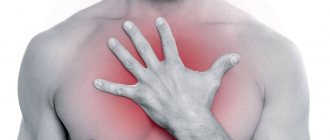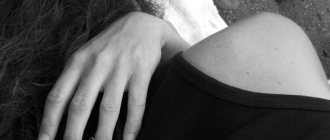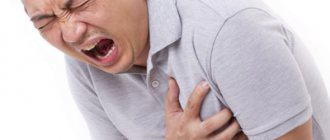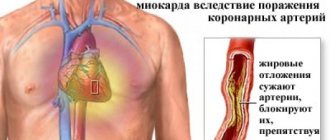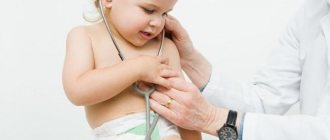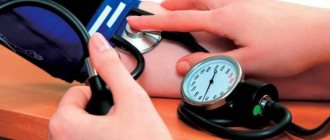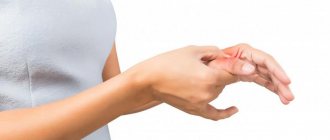Causes
The peculiarities of the sensitive innervation of the chest are due to the large number of internal organs and the close location of the main nerve bundles.
In addition, in medicine they use the concept of crossing zones of external and visceral (from internal organs) sensitivity with the formation of Zakharyin-Ged areas . Therefore, the appearance of sharp pain in the heart from the back is caused by the following conditions:
- injuries to the neck, chest or spine with pinched nerve fibers;
- diseases of the esophagus - tumors, diverticula (pathological protrusions of the muscle wall), strictures (narrowings caused by inflammation), varicose veins or rupture (perforation) of the wall;
- hiatal hernia;
- Osteochondrosis is a degenerative disease affecting intervertebral discs and vertebrae. It is characterized by pathological growth of bone tissue, increased load on the spine with the development of radicular pain syndrome, most often in the thoracic region and lower back;
- intercostal neuralgia - pain that occurs along the nerve (most often in the intercostal spaces), associated with mechanical action (spasmodic muscle or bone growth puts pressure on the nerve fiber, irritating it);
- Myocardial infarction is an acute condition characterized by necrosis (death) of part of the muscle mass of the heart due to impaired blood flow through the coronary vessels. More often it occurs after the rupture of an atherosclerotic plaque, the development of a thrombus (blood clot) or arterial spasm;
- dissecting aortic aneurysm - a violation of the integrity of the vascular wall associated with the leakage of blood between the layers and further destruction of the artery. The pathology is characterized by an acute attack in which the heart hurts and radiates to the back;
- angina pectoris is a variant of coronary heart disease, when compressive pain behind the sternum is observed with irradiation to the back, shoulder blade and left arm after physical activity. The disorder occurs due to a transient decrease in blood flow in the coronary vessels;
- acute bronchitis, tracheitis - inflammatory diseases of the mucous membrane of the respiratory tract.
In elderly patients, with spinal curvatures, and diabetes mellitus, cardiovascular pathologies occur atypically: the heart hurts from the back.
Associated symptoms
The severity of the heart disease, its location near the back and other features give the doctor a complete picture of the heart disease. An experienced cardiologist quickly finds the true cause of a specific heart disease.
However, only a doctor can make the correct diagnosis.
It is impossible to independently determine what causes pain in the heart area from the back and what its nature is.
Unpleasant breathing problems
When a person breathes, his lungs, ribs, back, chest and diaphragm work. If a malfunction occurs within any of the listed organs, the patient feels unpleasant discomfort in the back when breathing.
If a person feels pain near the shoulder blade while breathing, then the following parts of the body may be damaged:
- pericardium;
- ribs;
- pleura;
- spinal column;
- the space between the ribs.
The deeper a person breathes, the more intensely the diaphragm and lungs work. Even with minor damage, the patient feels sharp and severe pain.
Back pain when walking
Also, a person sometimes feels unpleasant ailments in the heart, which are palpable in the back if the patient turns his whole body or walks somewhere.
Thus, the patient suffers from the following bone and muscle pathologies of the back:
- osteochondrosis;
- degenerative and various dystrophic diseases of the back;
- myositis;
- neuralgia.
Such heart pain most often occurs in people who regularly, but strongly strain their back during sports, work, or, conversely, do not move much.
In some situations, a person experiences rib scapular syndrome, in which sudden specific movements of the patient are accompanied by an unpleasant crunching of the back.
Pain in the heart area or back pain?
Cardialgia (“cardia” – heart, “algia” – pain) is a painful sensation in the chest area associated with heart diseases of various etiologies. For patients with heart and back pain, a primary differential diagnosis is performed to determine the urgency and specificity of medical care.
Features taken into account:
- the connection of the attack with physical activity - the appearance of pain, shortness of breath and increased heart rate after the end of exercise indicates cardiac pathology. Pain in the back and heart that occurs after a sharp turn of the torso or head is often associated with pinched nerves;
- respiratory act – pathologies of the respiratory system are characterized by increased pain on inhalation and when coughing;
- eating - an increase in pain is observed when eating hot, cold and solid foods in patients with esophageal pathology;
- nature of the pain - paroxysmal stabbing - with angina pectoris, constant intense cutting - typical for aortic aneurysm, dull for a long time - chronic inflammatory and non-inflammatory heart diseases;
- zones of irradiation - the spread of an unpleasant sensation to the left arm, scapula and lower jaw are characteristic of a heart attack, localization in the upper right part of the chest - a dissecting aortic aneurysm.
In addition, the anamnesis (history of development) of the disease, the progression of the clinical picture and accompanying symptoms are taken into account.
Diseases of the esophagus are characterized by dysphagia (impaired swallowing), sensation of a foreign body behind the sternum, heartburn, and coating on the tongue.
With intercostal neuralgia, a constant pain syndrome is observed: the intensity does not decrease at night, unlike osteochondrosis. Sensitivity disturbances are noted with severe compression of the nerve: the limb goes numb for several hours. A sharp pinching of the nerve root causes the patient’s characteristic posture: leaning forward, the patient holds one side (the affected side) with his hand.
Acute cardiac pathologies (angina pectoris and myocardial infarction) are characterized by the sudden onset of pain, often to the left of the sternum. Additionally, cardiac arrhythmias (tachycardia), loss of consciousness, a feeling of fear of death, and severe shortness of breath are noted.
Possible heart pathologies
Even rare and short-term back pain in the heart area can be a sign of the onset of one of the diseases, some of which affect the cardiovascular system. These include:
- aortic dissection;
- myocardial infarction;
- pericarditis;
- angina pectoris.
Aortic dissection is a rare pathology that is provoked by serious injuries to the chest, thoracic spine, or long-term hypertension.
Characteristic symptoms are sharp, sudden pain, so severe that it practically incapacitates a person. Back pain in the heart area can also cause a blood clot, which can interfere with normal blood flow and trigger a myocardial infarction. In this case, the pain is pressing, radiating to the left arm, neck, jaw or chest. The attacks are prolonged, and the list of accompanying symptoms includes shortness of breath, nausea, and cold sweat.
Inflammation of the heart sac (pericarditis) is caused by viral infections. The disease is characterized by acute stabbing pain, which comes along with low-grade fever and weakness.
Angina pectoris is characterized by a slow progression of the disease. It occurs due to excess deposition of fatty plaques in the arteries. Pain in the spinal region appears after stress or physical activity. The pain is short-term, but “compressive”. The further the disease develops, the stronger the symptoms become.
What examinations to do
The effectiveness of treatment depends on making the correct diagnosis, therefore a clinical examination by a doctor and additional instrumental and laboratory research methods are used:
- electrocardiography (ECG) is a type of recording of the electrical activity of the heart, which is used to diagnose angina and myocardial infarction. The most informative is a recording during an acute attack of pain;
- echocardiography (ECHO-CG) is an ultrasound method for visualizing the chambers of the heart and great vessels. Used to diagnose dissecting aortic aneurysm, valve defects and hemodynamic disorders after a heart attack;
- X-ray of the chest organs - for the diagnosis of rib fractures, acute bronchitis. Examination of the abdominal cavity using contrast helps establish the diagnosis of hiatal hernia. Not administered to women during pregnancy due to the harmful effects of ionizing radiation on fetal development;
- radiography of the spine in the cervical, thoracic and lumbar regions - for the diagnosis of traumatic injuries or osteochondrosis;
- fibrogastroduodenoscopy is an endoscopic method for visualizing the hollow organs of the gastrointestinal tract, which is used to evaluate changes in the mucous membrane of the esophagus and stomach.
Laboratory diagnostics involves determining an increased number of leukocytes (nonspecific markers of inflammation) and troponins (sharply increased - a marker of myocardial infarction).
Features of “dangerous” pain
Of course, with any alarming symptoms, it is advisable to consult a doctor as soon as possible, especially if the suspicion concerns vital organs.
But patients themselves do not always understand which specialist they need to go to. Most of the “heartfelt” complaints actually concern completely different problems. One of the most common mistakes concerns osteochondrosis and cardiopathy. In both cases, the pain can be of any intensity, affecting the shoulders, arm or neck, but there are differences. Thus, with osteochondrosis, pain occurs with sudden movements and can last for a long time. Angina pectoris is characterized by short-term attacks after excitement or overexertion.
Heart pain is in most cases relieved with nitroglycerin tablets. For other pathologies, the drug will not bring the desired effect.
Myocardial infarction can disguise itself as an exacerbation of a chronic gastrointestinal disease. If the problem is related to the stomach, then discomfort usually appears within 1-1.5 hours after eating. Additional signs also appear - belching, vomiting, nausea or a feeling of heaviness in the abdomen.
Painful sensations in the chest and back often appear with pneumonia, especially if the inflammatory process develops in the left lung. In this case, the following are also observed:
- temperature;
- weakness;
- coughing;
- noises in the lungs;
- asymmetry of the chest.
Paroxysmal or aching pain with numbness of the limbs is a possible sign of neuralgia. If the lesion affects the nerve endings near the chest, the sensations resemble a heart attack. It is necessary to take into account the fact that neuralgia is characterized by prolonged attacks that intensify when walking or bending the body to the left or right.
Treatment options
The attending physician prescribes therapy after analyzing the research results and making a correct diagnosis.
For severe neuralgic pain, the following groups of drugs are prescribed:
- non-steroidal anti-inflammatory drugs - Diclofenac, Nimesil, Movalis (gels - for topical use, powder - for the preparation of oral solution);
- diuretics - to relieve edema (Furosemide, Hydrochlorothiazide, Spironolactone);
- reduction of muscle spasm – “Mydocalm”;
- improvement of metabolic processes - B vitamins (“Neurorubin”).
For cardialgia (angina or heart attack), the following treatment tactics are used:
- vasodilators: “Nitroglycerin” – one tablet under the tongue;
- antiplatelet drugs (lowering blood viscosity): Acetylsalicylic acid, Clopidogrel, Ticagrelor;
- oxygen therapy.
In case of a heart attack, anticoagulant agents are used (Heparin, Enoxaparin). Restore blood flow through the damaged area using percutaneous coronary intervention (stent placement).
For pain of other origin, depending on the diagnosis, the following treatment regimen is used:
- acute bronchitis or tracheitis - antipyretic and antitussive drugs, inhalations with antiseptic solutions. If necessary, antibacterial therapy;
- dissecting aortic aneurysm - urgent surgical intervention;
- diseases of the esophagus – antisecretory drugs (“Ranitidine”, “Pantoprozol”); ruptures, diverticula and hernias require surgical treatment.
For patients whose back pain radiates to the heart, nonspecific therapy is started after excluding acute myocardial ischemia, aortic dissection, or esophageal rupture.
conclusions
The appearance of pain localized in the sternum is caused by pathologies of the heart and structures located behind the pericardium. Determining the underlying cause by detailing the pain syndrome (character, intensity, irradiation and connection with breathing, physical activity and food intake) helps to choose further diagnostic tactics.
More often, pain of such localization is characteristic of myocardial ischemia or damage to nerve fibers. Patients who have aching heart or back are prescribed instrumental and laboratory procedures that confirm a certain diagnosis, after which adequate therapy is selected, aimed at eliminating both the symptom and the cause of the pain.
